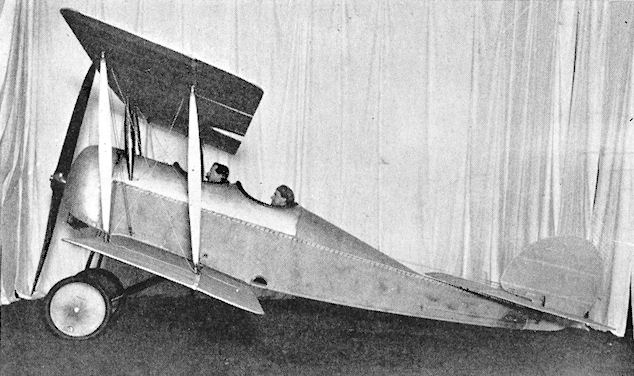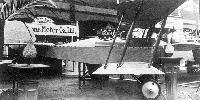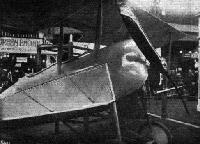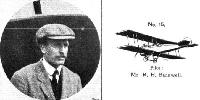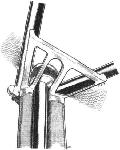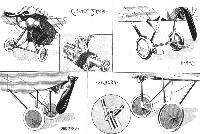C.Andrews Vickers Aircraft since 1908 (Putnam)
Scout Biplane - One 100 hp Gnome monosoupape. Accommodation pilot and passenger. Span 25 ft; length 20 ft 7 in; wing area 270 sq ft. Empty weight 600 lb; gross weight 1,200 lb. Max speed at ground level 100 mph; range 350 miles.
M.Goodall, A.Tagg British Aircraft before the Great War (Schiffer)
Deleted by request of (c)Schiffer Publishing
VICKERS tractor Scout biplane
This machine appeared at the Aero Show at Olympia in March 1914 alongside the EFB.3. The type was not developed since the firm was deeply involved with work on the Gunbus.
The aircraft was a conventional two-seater with single bay staggered wings of equal span with a cutaway in the top center section. The decking behind the pilot sloped steeply down to the semicircular tailplane, positioned well forward on the top longerons. Divided elevators and an aerodynamically balanced rudder were fitted. The undercarriage consisted of two pairs of vee struts of streamlined steel tube with a rubber cord sprung cross axle.
Power: 100hp Gnome Monosoupape nine-cylinder air-cooled rotary with Levasseur propeller.
Data
Span 25ft
Area 270 sq. ft
Length 20ft 7in
Weight 600 lb.
Weight allup 1,2001b.
Speed range 45-100 mph
Endurance 2 hr
P.Lewis British Aircraft 1809-1914 (Putnam)
Vickers Scout
In addition to showing their pusher E.F.B.3 Gunbus at the 1914 Olympia Aero Show, Vickers unveiled a two-seat tractor biplane scout. The machine was powered by the 100 h.p. Monosoupape Gnome driving a Levasseur propeller. Equal-span, single-bay staggered wings of low thickness/chord ratio were fitted, and the tailplane was of the lifting type. The airframe was of wood, covered with fabric. Span, 25 ft. Length, 20 ft. 7 ins. Wing area, 270 sq. ft. Weight empty, 600 lb. Weight loaded, 1,200 lb. Maximum speed, 100 m.p.h. Landing speed, 45 m.p.h. Endurance, 4.5 hrs.
Журнал Flight
Flight, March 14, 1914.
WHAT THERE WILL BE TO SEE AT OLYMPIA.
THE EXHIBITS.
Vickers (Vickers, Ltd.). (66.)
THERE will be two machines exhibited by Messrs. Vickers on their stand, one of which will be a two-seater fighting biplane with the engine and propeller to the rear of the wings, while the other will be a tractor biplane.
<...>
The tractor machine has a fuselage and main spars of wood, but the landing chassis is built of steel and is a very simple Vickers type, the wheels being suspended on rubber cord. It will be observed that a very wide speed range is claimed for this machine - from 100 to 45 miles per hour - and we shall look forward with interest for information regarding its performance. The wings on this machine are staggered. Both machines will be well up to the usual standard of excellence and finish found in the work turned out by this eminent firm of constructors.
On the fame stand various sizes of Vickers-Levasseur propellers will also be shown.
Flight, March 21, 1914.
THE OLYMPIA EXHIBITION.
THE EXHIBITS.
VICKERS (VICKERS, LTD.). (66.)
Two machines are exhibited on the Vickers stand - one a 100 h.p. fighting "pusher" biplane, whilst the other is a fast scouting tractor biplane.
<...>
The 100 h.p. Tractor Scouting Machine, similarly to the fighting biplane, is driven by a 100 h.p. Gnome monosoupape engine mounted on overhung bearings. This machine, which it is anticipated will prove very fast, is at present fitted with a comparatively small tank, which has a capacity sufficient for two hours' flight only, with pilot and passenger; but another tank, so designed that it can be fitted very quickly, may be carried instead of the passenger, which gives a capacity sufficient for 4 1/2 hours' flight. The fuselage of this machine is built up in the usual way of ash longerons, and ash and spruce struts and cross-members. The pilot's and passenger's seats are arranged in tandem with the pilot in the rear, and control is by means of a single, central column and a foot-bar. The usual set of instruments is carried on the dashboard in front of the pilot. The tail planes consist of a cambered fixed stabilisng plane, semicircular in plan view, to the trailing edge of which is hinged a divided elevator. The rudder is balanced, and no vertical fin is fitted. A tail skid sprung by rubber shock-absorbers inside the fuselage protects the tail planes against contact with the ground.
The chassis is of a very simple type, consisting of two pairs of V streamlined steel tube struts. In the V between the struts is earned the tubular axle, which is sprung by means of rubber cord. The angle of incidence on this machine is only 3°, and as the planes are absolutely flat on their lower surface, it should prove very fast indeed. The main planes are set at a slight dihedral angle, 1° to be exact.
In addition to the two complete machines, there are shown on this stand several examples of the Vickers-Levasseur propellers in various stages of construction.
Flight, May 22, 1914.
THE AERIAL DERBY.
THE PILOTS AND HOW TO RECOGNISE THE MACHINES.
No. 15. The 100 h.p. Vickers Biplane
is a small, fast tractor machine which will be a little difficult to distinguish from the Bristol machine No. 18. However, it has a considerably deeper and wider fuselage than has the Bristol.
THE MACHINES AND HOW TO RECOGNISE THEM.
No. 15 The 100 h.p. Vickers Biplane was also exhibited at the last Olympia Aero Show, and belongs to the small fast scouting type tractor biplane class. As this machine has not been flown in public up to the time of going to press, the speed is not known, but it is anticipated that the machine will prove very fast indeed.
Flight, November 5, 1915.
CONSTRUCTIONAL DETAILS.-IX.
<...>
The remaining two illustrations show the undercarriages of the Vickers scout and Ponnier monoplane. In the Vickers chassis the wheels are sprung, as shown in the sketches, whereas in the Ponnier no springing whatever is provided except that afforded by the pneumatic tyres. This last type of undercarriage may probably be said to be as simple as it is possible to make an undercarriage, and would be of little use on rough ground. It was, as a matter of fact, used on the machine flown by Emile Vedrines in the last Gordon-Bennett race at Rheims.

